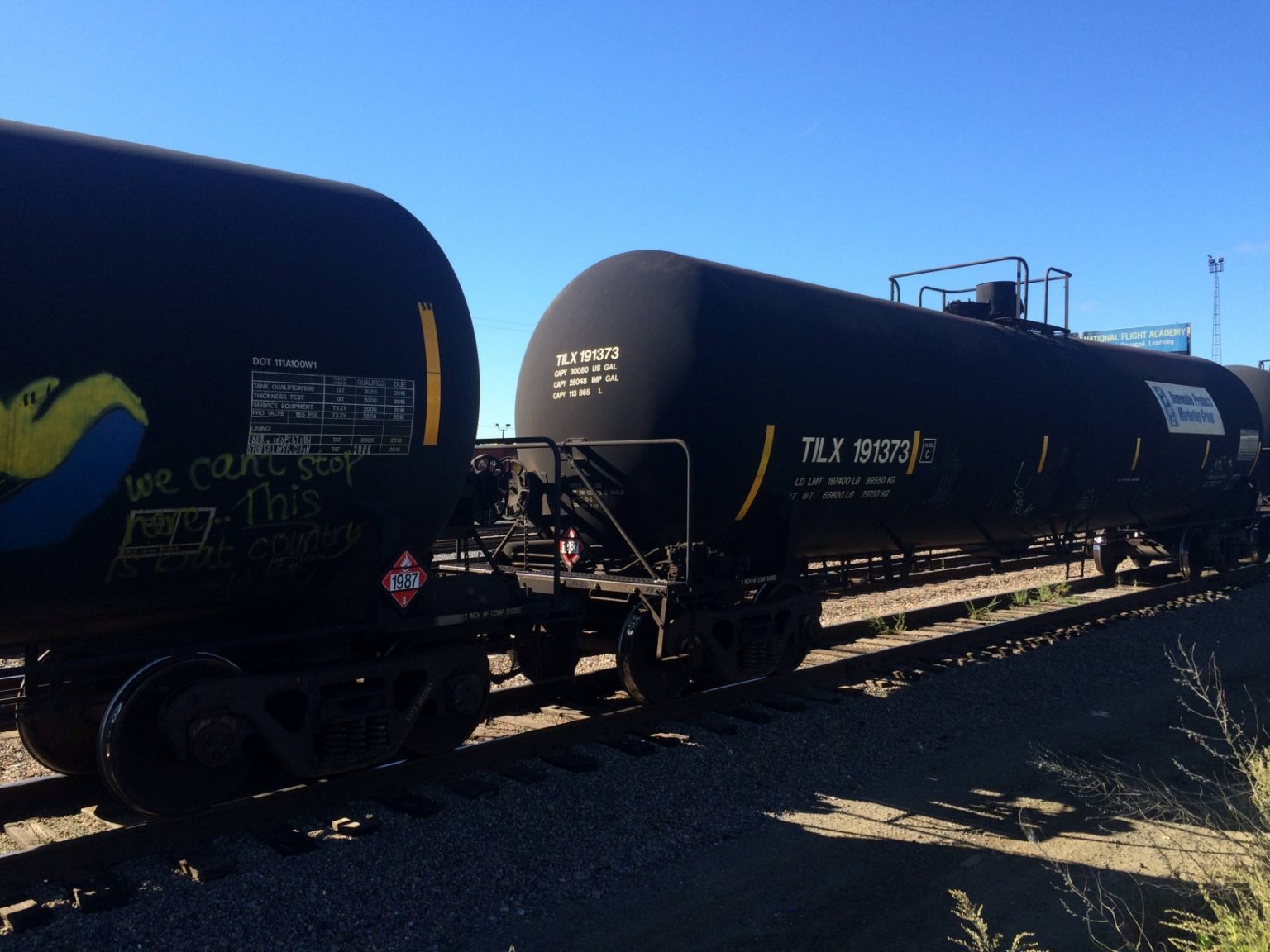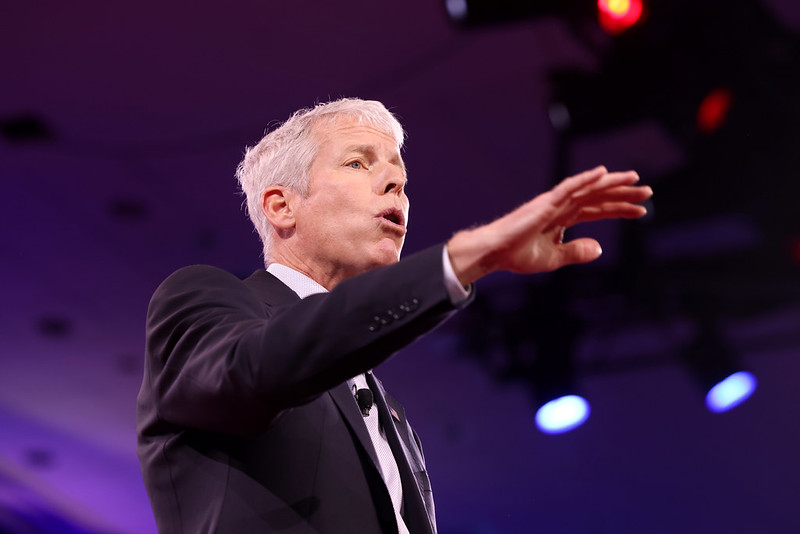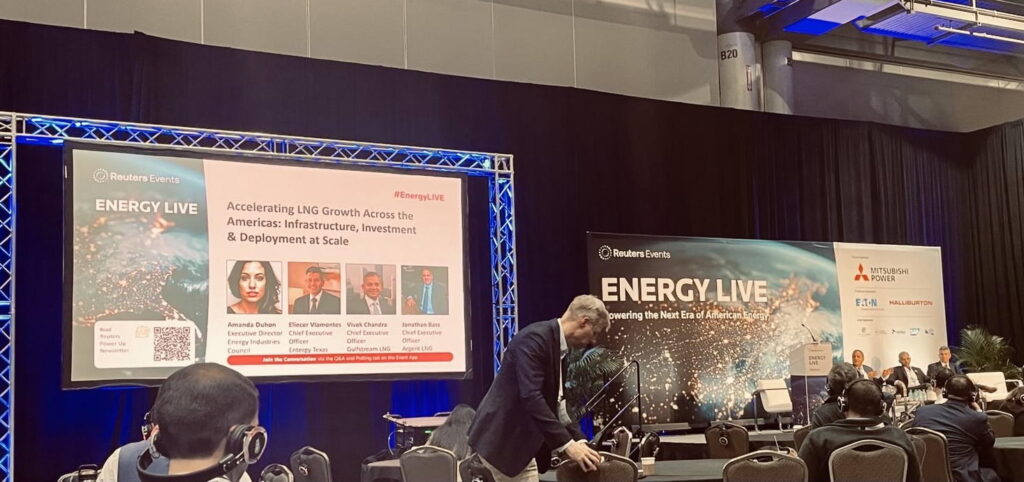This is part two in a DeSmog investigative series examining why oil trains derail at higher rates than ethanol trains. More ethanol was moved by rail from 2010-2015 than oil, but oil trains derail at a higher rate and with more severe consequences. Part one addressed train length as a potential factor in derailments.
“Sloshing is an issue. It increases in-train forces. It would be like having a heavy box in the back of your SUV that is not tied down. If you have to slam on the brakes, what happens? The box slides forward into the back of the seat in front of it.”
That was former locomotive engineer and rail safety consultant Bill Keppen describing the effects of “sloshing,” a phenomenon which happens when the liquid contents of incompletely filled rail tank cars start to move — or “slosh” — back and forth during transport. According to Keppen and others in the rail industry, that can potentially increase the chance of a train derailing.
Tim Hammond has 25 years of operations and management experience in the rail industry and currently works as the Chief Transportation Officer at Honeycomb Cargo. Hammond is confident sloshing is a real issue that can increase the chance of derailment and explained to DeSmog one way this can happen:
“If you have any type of sloshing forces that are going to slam forward, especially with the slack, it only lifts those wheels a half inch and you get a derailment.”
Slack, or “slack action,” refers to the level of free movement between a train’s loosely coupled cars that allows the train to bend around curves, and can be another risk factor when operating trains.
Hammond also commented on how sloshing can increase the severity of an accident, saying, “The surging or sloshing makes the derailment 10-fold worse just because it keeps pounding [cars] forward and piling them up.”
Keppen and Hammond — people with extensive experience operating trains and managing rail operations — believe sloshing is a legitimate issue that can lead to derailments in general. Could it be one of the reasons that oil trains, in particular, derail more often than ethanol trains?
Slosh Factors
One simple reason that sloshing might be more of an issue with oil trains than with ethanol trains is that crude oil is heavier than ethanol. Train tank cars have a total weight limit that regulations say can’t be exceeded. Individual tank cars carrying ethanol, a lighter cargo, are more likely to be filled nearly completely without surpassing the total weight limit. Fuller cars leave only a small amount of headspace, or “outage,” for the contents to slosh around.
However, the total weight limit for trains carrying crude oil, which varies in weight but can be significantly heavier than ethanol, can be reached before the tank car is full, creating more headspace.
As Hammond explained to DeSmog, “What happens is you gross out on the weight prior to filling up the vessel. Maybe the top 20 percent is air. It creates a lot of room to move back and forth — where ethanol is lighter and you have a full vessel and you don’t have the effect.”
Gabe Claypool is president of Dakota Plains Holdings — an oil-by-rail company that loads Bakken oil trains in North Dakota. This past July, at a National Transportation Safety Board (NTSB) roundtable on rail tank car safety, Claypool made it very clear that the industry is not filling tank cars all the way.
“We take a very systematic approach as an industry to loading these cars and they are all underloaded,” he said.
Is systemic underloading of cars increasing the risk of derailment for Bakken oil trains?
In response to a question about the differences between potential sloshing in ethanol tank cars versus crude oil tank cars, rail safety consultant Keppen told DeSmog, “If the level of oil in a tank car is lower than the level of ethanol, I would say the propensity for sloshing will increase — it’s just physics.”
Sloshing in Tank Trucks on the Highway
Bill Keppen’s example of having a loose box in the back of your SUV illustrates how having loose cargo could affect the handling of a motor vehicle on the road. Not surprisingly, sloshing is a well-known risk for tanker trucks carrying oil.
Sloshing forces can cause a tanker truck to roll over on a highway. In testimony for a case in which a gasoline truck flipped over and exploded on a California highway, engineer Don Margolis explained why tanker trucks were unique compared to trucks carrying other types of cargo.
“Loads can shift on all trucks, but the instability of a tanker truck is something that has been recognized for a long time,” said Margolis, a professor of mechanical engineering at UC Davis.
Tanker truck instability due to sloshing has been recognized for a long time. No one denies that. What is surprising, then, is that the rail industry claims sloshing is not an issue when it comes to oil-by-rail accidents.
One interesting thing to note is an actual “note” in a 2010 publication by the Association of American Railroads (AAR) called the “Field Guide to Tank Cars.” On page 30 of that publication, it states the following:
Note: Unlike highway cargo tanks, tank car compartments are not constructed by applying interior walls within a single tank. Further, unlike some cargo tanks, tank cars do not have interior baffles to control lading surges. (emphasis added)
Apparently the AAR was aware in 2010 that rail tank cars have issues with “lading surges,” which is another way to say “sloshing,” and the organization also noted that highway cargo tanks use baffles to control the flow of fluid cargoes, but rail tank cars do not.
Of course, in 2010 no one was worried about bomb trains because at that point, the oil-by-rail business was almost non-existent, and no other liquid products were being moved in large volumes in unit trains of over 100 tank cars.
Yet nowadays regulators, academics, and industry are making assurances that they have studied the issue of sloshing and determined it not to be a risk factor in derailments. However, each group has shown great reluctance either to explain this position or provide any of the studies allegedly supporting it.
RailwayAge Denied Access to Regulators
RailwayAge has been publishing news about the rail industry since 1856, making it transportation’s oldest trade magazine.
This particular publication became interested in the issue of sloshing in oil trains after Sarah Feinberg, who at the time was acting chief of the Federal Railroad Administration (FRA), told reporters on March 13, 2015 that the FRA was looking into sloshing as a potential cause of derailments.
Intrigued by this, RailwayAge submitted questions to the FRA on sloshing, and shortly thereafter sought:
“any documentation it may have on tank car slosh factors, specifically, ‘speed, acceleration, deceleration, curvature of track, grade of track, quality of track, degree of car loading (percent full), center of gravity (tank cars do not have heavy center sills that would lower the center of gravity; the tanks are the structural members), viscosity of contents.”
As RailwayAge reported, the FRA responded with an offer to “make its experts available for an interview.”
On the day of the interview, RailwayAge was told that these experts had issues with travel plans and that the interview would have to be rescheduled. After repeated attempts to reschedule the interview, David Thomas, contributing editor for RailwayAge, was unable either to obtain an interview or have his questions answered. Finally, Thomas sent the following message to the FRA:
“I would like to invite you for a third and final time to schedule an interview with your tank car slosh-factor experts. If I don’t hear from you soon, I will have to proceed with the article without FRA input. I would nonetheless have to mention that it was your Acting Administrator who raised the issue in the first place. It would seem she was all alone on this, without any support from FRA staff. I sincerely hope to avoid having to write the story without your technical insight.”
Thomas never got that technical insight.
DeSmog contacted the FRA requesting information on whether its study on sloshing had been completed or if the FRA had a “a position on the potential for sloshing to cause derailments.”
FRA spokesperson Matthew Lehner responded with the following:
“FRA continues to look at every aspect that we can to improve crude by rail safety. That includes FRA and VOLPE’s ongoing study of whether the sloshing of liquid inside a tank car has a significant effect on the probability of derailment.” VOLPE is the National Transportation Systems Center.
As DeSmog has noted, this “ongoing study” approach to oil-by-rail risk factors has been used to delay action on several known risks, including oil volatility, braking systems, and the risks of unit trains. Oil has been transported by rail via tank cars since the 1860s. It would seem reasonable to expect that the issue of the physics of oil in a tank car should be resolved and not require further study, but that is apparently not the case.
Industry Expert and Lobbying Group Says Sloshing Is Not An Issue
However, while the FRA continues to study this issue, the rail industry at large has concluded that sloshing isn’t an issue at all. In July, for hearings on the proposed Tesoro Savage oil-by-rail facility in Vancouver, Washington, Dr. Christopher Barkan testified in support of the project and commented on the issue of sloshing:
“Studies have been done. I’ll say roughly half a dozen or so studies have been done over the last three decades at least looking for an effect. Nobody has ever found a significant effect.
The railroad industry themselves, last year, re-asked this question because of the concern about some of the recent derailments and again looked through all of the literature that they could find and all of the tests and could find no evidence that this was having an effect.”
Dr. Barkan is a professor of civil engineering with the University of Illinois at Urbana-Champaign and leads research on rail safety, with funding from the railroads. Prior to Dr. Barkan’s current position, he worked for 10 years for the AAR, the rail industry’s top lobbying group.
Both industry and industry-funded researchers appear to have concluded that sloshing is not a factor in oil train derailments.
However, despite what appears to be consensus on the issue, DeSmog has been unable to obtain copies of the studies or the recent industry literature review which Dr. Barkan referenced in his testimony.
BNSF, one of the companies funding Dr. Barkan’s research and the train company that would be moving the oil to the proposed Tesoro Savage facility, responded to an inquiry, saying, “Your questions are best answered by the team at Vancouver Energy.”
BNSF failed to confirm whether they were involved in the recent industry literature review Dr. Barkan mentioned.
Vancouver Energy responded by saying, “As we are currently still in the adjudicative review process, it would be most appropriate for us to point you to the information Chris Barkan provided during his expert testimony.” That information did not include details of the alleged half dozen studies performed on this topic in recent decades.
Dr. Barkan did not respond to two email inquiries requesting information on these “half a dozen or so studies” he claims support the idea that sloshing is not a risk factor in oil train operation.
A spokesperson for the Association of American Railroads said with regard to these studies, he was “not in a position to release industry research at this time as it contains proprietary information.” However, he did say that “this is something that has been studied over the decades and continues to be monitored, but, evidence to date indicates sloshing does not have an effect on overall train handling.”
If research in the form of multiple completed studies has determined that sloshing is not a risk factor in oil train derailments, then where are these studies and why aren’t they available?
One place to look for insights into the world of rail operations is anonymous message boards such as the one on trainorders.com in which a conversation about sloshing occurred long before today’s Bakken oil trains. While this online conversation is filled with stories about the impacts of sloshing, the comment that sums up the issue best cuts to the chase: “To make a long story short, when it came time to stop for the red signal, I almost crapped all over myself.”
Lobbyists say sloshing isn’t an issue. People operating trains have a different story.
Sloshing — It’s Just Physics
Could sloshing of partially filled oil train tank cars be contributing to increased derailments among oil trains? If oil tank cars aren’t being filled completely and ethanol tank cars are, then sloshing seems more likely to occur in oil trains, perhaps helping account for the difference in derailments between the two cargo types.
However, a clear disconnect exists between what the industry says officially and what independent, experienced rail people such as Bill Keppen and Tim Hammond say about whether sloshing is a factor at all, regardless of the type of liquid in the tank cars. The industry, while failing to provide any supporting data or documentation, claims evidence abounds and concludes that sloshing is not a factor in derailments. They hold this position despite the Association of American Railroads having acknowledged the existence of “lading surges” in tank cars as recently as 2010.
While public relations officials and a professor currently funded by the rail industry and formerly employed by a rail lobbying group both contend that sloshing isn’t an issue, people like Tim Hammond see things a little differently.
“You’re talking about some extreme forces,” he said, “and when you throw that sloshing back and forth on top of it, and it doesn’t necessarily have to lift the wheels — that is just one of the ways you can have a major incident. Sloshing is definitely an issue and not just an issue that creates derailments, but it is a major issue in many cases I’ve investigated that makes a small derailment a big derailment.”
Or, to repeat former locomotive engineer Bill Keppen, “It’s just physics.”
While we await the results of the industry’s and government’s studies —150 years after the first oil tank car rode the rails — we should keep in mind the warning of Christopher Hart, current head of the National Transportation Safety Board.
“We’ve been lucky thus far that derailments involving flammable liquids in America have not yet occurred in a populated area,” Hart said. “But an American version of Lac-Mégantic could happen at any time. Instead of happening out in the middle of a wheat field it could happen in the middle of a big city.”
The Bakken oil train explosion in Lac-Mégantic, Quebec, Canada, killed 47 people.
As these safety issues are ignored, dismissed, or continued to be studied, an important question remains: How long until that luck runs out?
Main image credit: A unit train of graffiti-covered DOT-111 tank cars. Justin Mikulka
Subscribe to our newsletter
Stay up to date with DeSmog news and alerts






